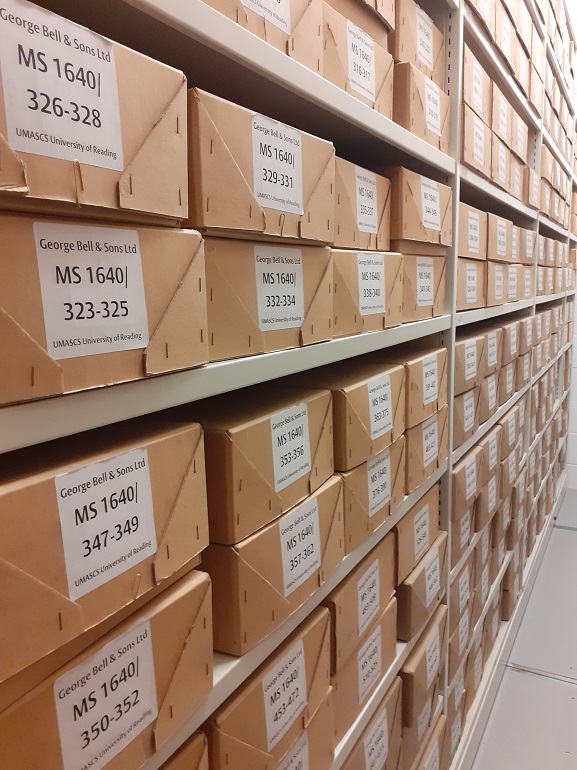George Bell & Sons Ltd. Archive
 In 1839, George Bell set up shop at 1 Bouverie Street, London as an educational book supplier, announcing himself as the London outlet for university publishers. Having established a secure income from retail, he began in 1840 to bring out his own publications, specialising in classical texts and practical handbooks such as his Railway Companions. He outgrew his Bouverie Street premises within a year, and moved to 186 Fleet Street. During the next decades, he continued to expand the publishing arm of his business, while remaining in business as a bookseller. He gained a reputation for books on art, architecture and archaeology, largely through his friendship with Henry Cole and his associates, but continued to be known chiefly for his educational output, benefiting from good connections with many noted headmasters. During the 1850s, he also ventured into children’s literature, publishing the work of Margaret Gatty, and later that of her daughter, Juliana Horatia Ewing.
In 1839, George Bell set up shop at 1 Bouverie Street, London as an educational book supplier, announcing himself as the London outlet for university publishers. Having established a secure income from retail, he began in 1840 to bring out his own publications, specialising in classical texts and practical handbooks such as his Railway Companions. He outgrew his Bouverie Street premises within a year, and moved to 186 Fleet Street. During the next decades, he continued to expand the publishing arm of his business, while remaining in business as a bookseller. He gained a reputation for books on art, architecture and archaeology, largely through his friendship with Henry Cole and his associates, but continued to be known chiefly for his educational output, benefiting from good connections with many noted headmasters. During the 1850s, he also ventured into children’s literature, publishing the work of Margaret Gatty, and later that of her daughter, Juliana Horatia Ewing.
In 1854, Bell acquired the Cambridge firm of J. & J.J. Deighton, which was renamed Deighton, Bell and Company. Despite installing W. Wright Smith as resident partner in Cambridge, Bell was acquiring too many personal responsibilities. In 1856, he therefore entered into partnership with Frederick R. Daldy. The firm continued with educational publishing but also expanded its interests. Bell & Daldy published the Aldine Edition of British Poets, acquired by Bell in 1854, and began to bring out other volumes of verse, including some of the work of Andrew Lang and Robert Bridges. English and foreign-language dictionaries were another addition to the list, after Bell acquired the British rights to Webster’s Dictionary.
In 1864, Bell and Daldy acquired the Bohn Libraries, which at that time consisted of over six hundred works, with copyrights, plates and stock. As a result, the retail side of the business was no longer necessary, and the partnership took over the Bohn houses in York Street, Covent Garden. In 1867, they gave up the Fleet Street address. Also at this time George Bell’s son Edward graduated from Cambridge and began to work for the family firm.
The partnership between Bell and Daldy came to an end in 1873. It had been strained when Daldy committed the firm to a large financial interest in the debts of the publisher Alexander Strahan. In the end, Daldy joined the new firm of Virtue, Spalding and Daldy, and Bell’s firm was renamed George Bell & Sons. The business continued to thrive throughout the late nineteenth century. Bell acquired the Chiswick Press in 1880 and it was managed by his brother John until the latter’s death in 1885. The Press continued to be associated with the Bell firm until 1919.
George Bell settled the firm on his sons Edward and Ernest in 1888 but continued to come into the office until his death in 1890. The firm under Edward Bell continued to publish scholarly and educational works but also expanded its overseas connections. In 1910, the firm became a limited liability company and erected its own building, York House, on Portugal Street.
Edward Bell died in 1926 and was succeeded on the board by his son Arthur, the last Bell to serve in the firm, who was chairman from 1936 until his death in 1968. By this time, the active management had been taken over by others, including Guy Bickers, managing director for many years. After WWII, George Bell & Sons specialised almost wholly in educational books, under the leadership of A.W. Ready, a leading figure in the field, who died in office as managing director in 1967. A small general list was still maintained under S.L. Dennis. When R.P. Hyman became chairman and managing director in 1977, the firm became Bell & Hyman Ltd and moved to Denmark House, Queen Elizabeth Street, where it remained until going out of business in 1989.
The collection contains correspondence, ledgers and miscellaneous records from 1813–1976, although the nineteenth century records are rather fragmentary. Some material is included from the subsidiary firm The Chiswick Press, purchased in 1880. The collection has been summarised as follows:
- Legal and financial records
- Directors’ correspondence with authors, 1925-1968
- Correspondence relating to particular books, production department and editorial department correspondence, out-letter books and letters from authors, including correspondence relating to particular staff including Richard Bell, S.L. Dennis, A. W. Ready, R.J.B. Glanville, W.H. Mills, and M.H. Varvill
- Financial records for Chiswick Press including balance sheets and stock lists, 1838-1972
- Division files, 1926-1938
- Reviews, 1957-1966 (approximately 97 folders)
More Information
- A catalogue is available to view on The National Archives’ catalogue, Discovery: George Bell & Sons